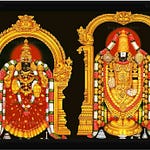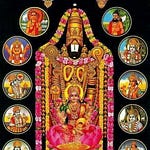The world we live in is hierarchical: power appears in different forms and is distributed differently. And yet when compared to the infinite exaltedness of Lord Śrīnivāsa and Padmāvatī Tāyār, our differences in power are flattened out into nothing. Verse 18 of the Śrī-Veṅkaṭeśa-Suprabhātam illustrates exactly this, with some important consequences for our mindsets and our behaviors.
Sūryê-Indu-Bhauma-Budha-Vākpati-Kāvya-Sauri- Svarbhānu-Ketu-diviṣat-pariṣat-pradhānāḥ | tvad-dāsa-dāsa-caramâ-avadhi-dāsa-dāsāḥ Śrī-Veṅkaṭâcala-pate! tava suprabhātam || (VSu 18) सूर्ये-ऽन्दु-भौम-बुध-वाक्पति-काव्य-सौरि- स्वर्भानु-केतु-दिविषत्-परिषत्-प्रधानाः । त्वद्-दास-दास-चरमा-ऽवधि-दास-दासाः श्रीवेङ्कटाचल-पते! तव सुप्रभातम् ॥
The Nine Planets Sūrya (sun) Candra (moon) Maṅgala, son of the earth (Mars) Budha (Mercury) Bṛhaspati, lord of speech (Jupiter) Śukra, descendant of Kavi (Venus) Śani, sun's son (Saturn) Rāhu (north lunar node) Ketu (south lunar node) who are the foremost in the assembly of the gods become the servants of the servants of the lowest level of the servants of the servants of You: O Lord of the sacred mountain wealth-weaving, sin-cleaving Venkatam, a blessed morning unto You!
This is a very powerful verse because it demonstrates the effect of devotion to Lord Śrīnivāsa. It can also be understood in multiple ways—but then that is true for so many verses here!
A hierarchy
The Nava-grahas are the Nine “Planets” of classical Indian jyotiṣa or astro(nomy|logy).1 Translating the word graha as “planet” is misleading, as only five of these entities are planets as we understand them today; one graha is a star, one is a moon, and two grahas (Rāhu and Ketu) are in fact not physical entities at all but abstract points representing the mathematical intersection of the moon’s orbit with the earth’s ecliptic. The literal translation of the word graha would be something more like “grabber” or “grasper”, reflecting the power that these entities are supposed to exert over other beings. Indeed, the verse describes the Nava-grahas as being dominant even in the assembly of the gods, because even the gods are susceptible to the power of the Nine.
Consequently, to this day the Nava-grahas are propitiated quite widely by Hindus, and figure in many Hindu temples (particularly non-Vaiṣṇavite temples). They are respected and feared, and people go to great lengths to appease the Nava-grahas at various points in their lives. This is a very old tradition, and stems from the general and extremely widespread belief (not limited to India alone) that the planets have a key role in determining the course of human lives.
Inverting the hierarchy
The verse suggests, however, that devotees of Lord Veṅkaṭeśa and Padmāvatī Tāyār have nothing to fear at all from the Nava-grahas. Far from being potentially malefic entities, they are in fact servants of these devotees, working to their benefit and helping them grow in their service to the Lord.
This verse thus points to an important shift away from fear-driven self-interested propitiation of deities to love-based, selfless service and devotion to the Supreme Lord and Lady of the Cosmos. This shift in mindset is arguably one of the great achievements of the Śrīvaiṣṇava tradition. And since the Nava-grahas are also ultimately servants of the Divine, they are guaranteed to work in Their devotees’ interests, and in this sense to serve and benefit all of them. Such is Lord Śrīnivāsa’s magnificence and such is the love of all the celestial beings for Him and His devotees!
Inverting the inversion (sort of …)
Now, while it would be wrong for devotees of Lord Veṅkaṭeśvara to fear the Nava-grahas, it’s possible to go too far in the opposite direction too, and adopt an attitude of irreverence or contempt towards these deities: after all, doesn’t the verse describe them as lowly servants of the Lord’s devotees? But this is also an incorrect position to take, for two reasons.
The first reason is that it is a rather egoistic position to assume that we qualify as being true devotees of the Divine! It is true that the Lord asks for very little indeed—a leaf, a flower, a fruit, or even water suffices as an offering,2 and failing that, even an act of imagination is enough. But it is also true that being egotistical about one’s service to the Lord makes it that much harder to continue to grow spiritually. Thus, even though we might have no reason to doubt that we are devoted to the Lord and thus beneficiaries of the Nava-grahas’ good graces, cultivating an attitude of irreverence to them or to other deities cannot be spiritually beneficial in the long run.
The second reason is that this verse actually also contains a hint as to the source of the Nava-grahas’ power: One of the greatest ways to serve the Lord is by serving the devotees (bhāgavatas) of the Lord, known as bhāgavata-kaiṅkarya. In fact, bhāgavata-kaiṅkarya is arguably even superior, or at least equivalent, to serving the Lord directly (Bhagavat-kaiṅkarya) for two reasons:
The Lord does not need our offerings per se (even if they are a source of delight to the Divine). Serving human beings in their time of need, and selfless devotees of the Divine at that, thus fulfills an important purpose in parallel to serving the Divine.
If we serve devotees selflessly during their time of need, we are in effect transforming ourselves into instruments of the Divine Will. This is a spiritually beneficial exercise as it reduces the hold of the selfish ego over our actions.3
By this token, then, the Nava-grahas are supreme devotees (parama-bhāgavatas) of Lord Śrīnivāsa! By serving not just His devotees, but their devotees and their devotees and so on in turn, the Nava-grahas are enabling a whole chain of actions of Bhagavat-kaiṅkarya and of Bhāgavata-kaiṅkarya. In fact, one could stretch this line of thinking to make the argument that it is this very service to the devotees of Lord Veṅkaṭeśvara that is the real source of the Navagrahas’ powers.
Thus, while orthodox Śrīvaiṣṇavas do not have an obligation to worship the Nava-grahas (since they worship the Supreme Deity directly), it is still important to be respectful to these beings who support the true devotees of the Lord.
A psychological perspective on the nava-grahas
In a space-faring era where human-made satellites have orbited multiple planets and human-made rovers have landed on multiple celestial bodies, people sometimes find it hard to digest talk about the Nava-grahas: it reeks to some people of astrology and pseudo-scientific babble from a pre-modern world. Even the interpretive shift to treating the Nava-grahas not as the celestial bodies themselves but as deities embodied in or as those celestial bodies can seem too fluffy for some people.
An alternative way to approach the Nava-grahas, which removes or at least ignores their celestial connection, is to treat them as personifications and symbolic encodings of very real and very human bundles of thoughts. emotions, traits, dispositions and tendencies. These bundles interact with one another, amplifying and dampening one another in complex ways. Different bundles can be adaptive for success in certain environments, but maladaptive in others. (Thus, for instance, Śani / Saturn is sometimes feared as being the governor of limitations, strictness and so on. While self-limitation can be “bad” in certain contexts, holding us back from success and slowing us down, it can also be valuable in the form of self-discipline, habit- and routine-formation, grit and perseverance through tough times, and so on.)
This verse also makes sense from this psychological perspective, especially in light of our personalized interpretation of adhikāra from verse 17:
When we have properly identified our adhikāra in this world—not necessarily in a socially-ordained sense, but in a holistic and deeply personal sense—and when we live out our adhikāra in service to Lord Śrīnivāsa and Padmāvatī Tāyār, then we will find ways to harmonize our own internal conflicts and desires in a way that serves this Higher Goal.
Thus, devotional service becomes a way to integrate our psychological fragments into a whole, holier self.
Coda: A possible inspiration for this verse
Swāmī Deśikar has a beautiful verse, filled with paronomasia (śleṣa), in his Pādukā-Sahasram that similarly describes the relationship between (seven of) the Nava-grahas and the sandals (pādukās) of the Lord.
kanaka1-rucirā, kāvyâ2-ākhyātā, śanaiścaraṇô3-ucitā, śrita-guru4-budhā5, bhāsvad6-rūpā, dvijâ-adhipa7-sevitā | vihita-vibhavā nityaṃ Viṣṇoḥ pade Maṇi-pāduke! tvam asi mahatī viśveṣāṃ naḥ śubhāgraha-maṇḍalī8 ||
At least 8 different words in this verse can be interpreted in multiple ways, and I have therefore indexed them with superscripts. In the translation below, I’ll reference the superscripts to indicate what meanings are being extracted from a particular word.
Lustrous 1(with a golden-red hue | like Mars), Acclaimed 2(in the great epics | by Śukra, descendant of Kavi), Well-suited 3(to the feet of the Lord for eternity | to slow-moving Śani), Refuge for 4(the Teachers | Bṛhaspati, teacher of the gods) and 5(the Sages | Budha the clever), In form 6(radiant | like the brilliant Sun), Served by 7(the best of brahmins | the Moon, lord of the twice-born): O bejeweled Pādukā! You whose glory comes from Your eternal association with Viṣṇu’s feet are for all of us, for the whole cosmos, an eternally magnificent 8(collection of purely auspicious blessings | assembly of purely auspicious planets)!
|| Śrī-Padmāvatī-nāyikā-sameta-Śrī-Śrīnivāsa-parabrahmaṇe namaḥ ||
There was not a sharp division, or even any division whatsoever, between the two fields of astronomy and astrology in classical India, unlike today when they are completely sundered.
As the Blessed Lord Kṛṣṇa promises to Arjuna in the Śrīmad-Bhagavad-Gītā:
patraṃ, puṣpaṃ, phalaṃ, toyaṃ: yo me bhaktyā prayacchati | tad Ahaṃ bhakty-upahṛtam aśnāmi prayatâtmanaḥ || (BhG IX.26)
A leaf, a flower, a fruit, some water: I gladly partake of any of them, offered with devotion by one who does so devotedly, with a pure mind.
The formal recitation of the acknowledgement of this situation, where Śrīman-Nārāyaṇa is the ultimate Agent and we are His instrument, is known as the sāttvika-tyāga and is performed by Śrīvaiṣṇavas at the beginning and at the end of every ritual ceremony. But it is easier to feel this selflessness in action when serving someone than when rushing through the words in order to just get a ritual done.









Share this post